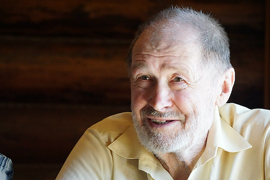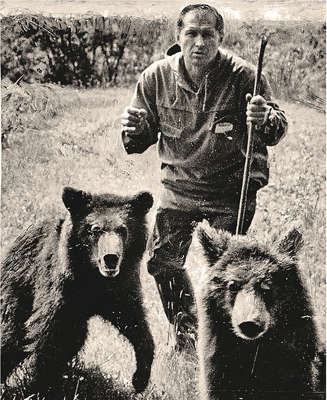
Valentin Pazhetnov – this name is known all over the world. Honored Ecologist of Russia, Doctor of Biological Sciences, developer of a unique method of rescuing and returning clubfoot babies to the wild. He founded and for many years ran the Rescue Center for Orphaned Bears.
And – as always – the legendary KP observer Vasily Peskov had something to do with the discovery of this nugget to the world. It was he who wrote about the experiment in the late seventies.
Pazhetnova several large essays. Here is an excerpt from the second material by Vasily Mikhailovich:
“During my life I have seen many interesting people – from Marshal Zhukov to Agafya Lykova. With Valentin Sergeevich Pazhetnov, we became friends from the first day. A man of rare charm! And very skillful.
In his youth he was a shepherd – grazing horses, in the same place, in Siberia, he became a commercial hunter. In the steppe region he worked as a combine operator and tractor driver, in the winter he was a mechanic in a workshop. He graduated from the institute and became a competent zoologist in the reserve. Can work as a carpenter, blacksmith. In his declining years, he sat down to describe his life lived – it turned out to be a big good book.
What else can you say about a person? The wife is a friend and helper, the children followed in their father's footsteps. And grandchildren too. In the place where they live, the old women pray to God “for the health of Valentin Sergeevich” – they can take them to the hospital, they will get some medicine, they will send them to plow the garden. I found a friend in him who turned out to be a fellow countryman – his grandfather lived in the small town of Bobrov, Voronezh region.

Fate sent bears to Valentina Sergeevich when he began to work in the Central Forest Reserve. An experienced zoologist decided to return the cubs that were left without a mother to nature …
Raising an orphaned bear cub in the yard or in the house is not difficult. But hardly anyone succeeded in returning an adult animal to nature. The beast, which did not pass the forestry school, was drawn again to the man. You can remember many different stories, how bears robbed passers-by on the roads, threw their paws into the bodies of mushroom pickers. The fate of such animals is always the same: a chain or a cage, and more often a shot. ” That is why the experience of the zoologist Pazhetnov was so interesting.
The end of the first experiment did not live up to expectations. The “graduate” released into the wild soon showed up … News came from the village adjacent to the protected forest: a bear lifted a heifer. This alarmed – bears rarely attacked livestock here. A week later, another piece of news from the same village: a bear in the yard killed two sheep. “Now I no longer doubted … And when they said: on the road to the village, the bear was chasing a forester passing by on a horse, I realized that it was my duty to forestall a great disaster. What was to be done? He took a gun and, asking about the bear's habits, set up an ambush near the village …
You can imagine what I went through. It was he, my pupil – a bear not wild and not tame, having no fear of people, incapable of wild life in the forest … “
Any other person would put an end to this. “It is impossible to return a tamed animal to nature!” Valentin Pazhetnov decided to recall with a cold head: what mistakes could he have made during the two-year experiment? He saw the mistakes.
“On reflection, I drew conclusions from an unsuccessful experiment … It is necessary to release the babies in the same year when they lost their mother. And the most important thing: bear cubs should be raised without the presence of people, animals in no case should receive food from human hands … “
The very first release on a carefully thought out program turned out to be successful. In the first weeks, the cubs were fed milk from a bottle with a nipple. Then they were given oatmeal, wheat or buckwheat porridge with vitamins. This food was very nutritious and the cubs in the nursery grew fast and were healthy. But when they were released from the “nursery-den”, the food from the porridge was cut in half – “it's time to get food ourselves.” The cubs ate young grass, ants, snails, and caught frogs in the pond. But they still resorted to porridge at the end of the day …
In 1985, in the dense forest of the Toropetsky district of the Tver region, according to Valentin Sergeevich's drawings, on the site of the deserted village of Bubonitsa, a zoo “Clean Forest” was created, where the cubs were waiting for a reliable shelter …
At the base in Bubonice, things are getting better every year. In winter, little bear cubs appear (in some years there were more than twenty of them), and at the end of summer the animals are released into the wild. They try to release them where their parents lived: in the forests of Yaroslavl, Novgorod, Pskov, Tver, Smolensk regions.
SCHOOL in Tver forests is the pride of our science. It was visited by zoologists from different countries – France, Germany, Scandinavia, India, Korea and Japan. They're going to study! US biologist John Beachom has lived in Bubonice four times. The result is obvious. He, following Pazhetnov, began to return orphaned babies to nature and returned more than a hundred already ”.
The whole Pazhetnov family gradually began to deal with the rescue and study of the clubfoot orphans. For 26 years of work, they have raised and returned to the wild 263 cubs. Their charges live in 19 regions of Russia, including those where the brown population was on the verge of extinction.
Valentin Sergeevich had many more plans to expand the scale of rescuing young bears. But a fishing accident ended his life so tragically. But not work. The Pazhetnov case will be continued, and hundreds of cubs will return to the forests. To the very forests where the soul of the bear dad went to eternal rest.

